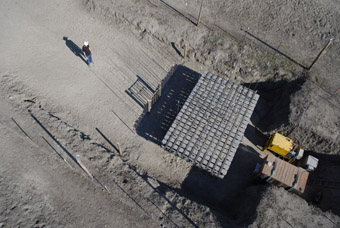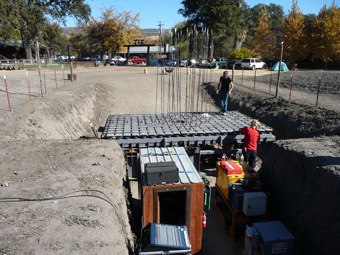the science-art of quakes
michael wall: australian dv rogers’ pieqf in california

PIEQF, Parkfield Interventional Earthquake Fieldwork taken by Kite Aerial Photography,
photo Scott Haefner, U.S. Geological Survey
PIEQF, Parkfield Interventional Earthquake Fieldwork taken by Kite Aerial Photography,
PARKFIELD IS A STRANGE PLACE TO HOLD A PARTY. THE CENTRAL CALIFORNIAN TOWN, POPULATION 18, HAS ONE RESTAURANT AND ONE SMALL INN, AND GETTING THERE TAKES SOME DOING. IT’S IN ROLLING-HILL RANCH COUNTRY HALFWAY BETWEEN SAN FRANCISCO AND LA, FAR FROM THE SEA.
But what happened here on a warm Sunday morning this past November was definitely a party. Dozens of people—young and old, hipsters and housewives—crowded the rough-hewn tables of the Parkfield Café, loading up on half-pound burgers and big country breakfasts. Others lounged on the oak-shaded lawn just outside, eating picnic lunches, drinking beer and watching someone’s golden retriever splash about in the café’s fountain. Still more milled around in a dusty lot next to the lawn, staring down into a pit that could bury a brontosaurus.
At the bottom of this hole sat an ungainly contraption, a chest-high platform the size and shape of a tennis service box. But any association with tennis was fleeting, because the thing was not genteel. It was all sharp corners and rugged bolts and cables and hoses. Thirty 10-foot-high metal rods rose from its steel-slat surface, scraping the blue Autumn sky. It looked like a giant mechanical spider lying on its back in an open grave.
And everyone was here to see it. The machine was the Parkfield Interventional Earthquake Fieldwork (PIEQF), a melding of science and art. Sydney-based artist DV Rogers set it up in Parkfield in August, after more than a decade of planning, recommissioning, tinkering, and scrounging for funds. This was its last day of operation, and the gathering, at least 75 strong, was a send-off.

PIEQF, Parkfield Interventional Earthquake Fieldwork, DV Rogers
photo Mike Wall
PIEQF, Parkfield Interventional Earthquake Fieldwork, DV Rogers
The PIEQF is a modified shake table, which engineers use to test how buildings handle earthquake stresses. Rogers linked it up with a network of United States Geological Survey (USGS) seismic sensors across the state. Any time a quake above magnitude 0.1 struck anywhere in California—and this happens about 40 times every day—hydraulic pistons made the PIEQF shudder, rattle and clank. The steel rods bent and swayed like coral polyps in a current. The more intense the quake, the longer the shake.
Rogers put it here, in this tiny town two hours from anywhere, because Parkfield is the earthquake science capital of the world. It sits directly on the San Andreas Fault, a 1300-km-long gash in the ground where the Pacific and North American tectonic plates meet. If California ever cracks off the West Coast and sinks into the Pacific, the San Andreas will likely be to blame. Slips of the fault caused both the 1906 San Francisco earthquake (magnitude 7.8, 3,000 dead) and the 1989 Loma Prieta temblor, centred just north of Monterey Bay (magnitude 6.9, 63 dead).
Parkfield itself gets hit hard and often. Since 1857, seven magnitude 6.0 quakes have hit the area every 20 to 30 years, the last coming in September 2004. Scientists reckoned they could learn a lot about quakes—and maybe even improve their predictions—by studying a place with such regular, repeating ones. So in 1985 the USGS established a massive monitoring presence in Parkfield, and the agency has been here ever since.
The PIEQF—“part machine, part earthwork, part performance”, according to Rogers—was like a seismic antenna, transforming subterranean shock waves into machine-mediated sound and motion. And it was here to give anyone who stopped by, or visited Rogers’ website with its live video feeds (http://pieqf.allshookup.org/), a glimpse of the earth’s churning, straining heart. The PIEQF was very much a site, in the sense articulated by one of Rogers’ biggest inspirations, the American land-art pioneer Robert Smithson. That is, it drew a great deal of its power from being here, in Parkfield, on one of the planet’s widest, longest wounds. All this activity is right under our feet, and we never think about it. Forty quakes a day. Listen to your earth. And watch it move.
The PIEQF made visual the buried dynamism of the landscapes in which we live. It firmed up our sense of place, and our sense of time. For this force, 40 quakes a day, may destroy our buildings, our roads, our bridges, but at heart it is generative. It raises mountains and clears paths for lava to rise from hot, hidden depths. It has shaped the Earth steadily, constantly, over billions of years, and seeing those rods dip and sway reminded us of this fact.
This was a message Rogers wanted the PIEQF to get across. “We engage with geological time in a very shallow way”, he said. “I’m interested in introducing a human timescale to geological time.”
At 12:30, Andy Michael clambered atop the PIEQF, trombone in hand, joining two cellists and a vocalist on the mechanical beast’s back. Michael, a USGS seismologist, initially got Rogers interested in Parkfield a few years ago. And he helped get Rogers the official-sounding (but unpaid) title of USGS artist-in-residence.
The four musicians played two short songs Michael composed: “Earthquake Quartet”, written in 1999, and “Fanfare,” conceived the night before at the party in Parkfield. “Earthquake Quartet” incorporates actual seismograms as percussion, and it is the reason Michael and Rogers first touched base: Rogers heard about the piece and dropped Michael a line.
At the end of “Fanfare”, as the vocals died and the keening of strings leached into the dust, the PIEQF got a solo. For 30 raucous seconds it clattered, clanged, and shuddered, its metal slats rising and falling. But then the pistons stopped pumping, and, after 91 days of continuous operation, 43,000 webcam frames, and more than 4,000 earthquakes, it too was silent.
Now the PIEQF sits in secure storage, waiting for its next curtain. In many ways, Parkfield was just a warm-up. Rogers wants to install it in an urban setting as soon as he can raise the funds. He’s thinking LA, 2010. It’s another earthquake-prone city, and one that desperately needs an appreciation of deep time.
DV Rogers, PIEQF, Parkfield Interventional Earthquake Fieldwork, Parkfield, California, Aug 18-Nov 16, 2008. http://pieqf.allshookup.org
RealTime issue #89 Feb-March 2009 pg. 30






